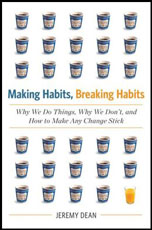"Not all habitual negative thoughts are bad and should be changed. Since psychologists are often faced with people suffering the depressing consequences of habitual negative thoughts, we know more about them than negative habitual thoughts that have neutral or even positive consequences. This may sound like a contradiction, but it's not, because negative habitual thoughts can have positive consequences. In fact, the dividing line between positive and negative outcomes can be thin.
"The simplest example is worrying. We've talked about worry in the guise of rumination and anxiety and their negative consequences, but worry can also be good for you. For example, studies have found that people who worry more perform better at work, are better at dealing with stressful events, and can do better at school. They may even be more healthy as a result of being more likely to engage in health-promoting behaviors. The reason for this is obvious when you think about it. People who worry about their performance at work are more likely to try and improve it, and the same goes for students' academic performance and health behaviors. So the question becomes about the type of worrying. Edward R. Watkins from the University of Exeter has suggested that one of the vital differences between constructive and unconstructive worrying is hidden in the character of thought.
"Let's imagine two ways of worrying. In the first, let's say you're worrying about your health. You've noticed some pain in your leg and so you start to worry about it. This prompts you to think about other bodily problems and the general problem of the body's weakness. You wonder abstractly how long you have to live and then, increasingly morbidly, how many people will come to your funeral. Meanwhile, the leg continues to hurt. Here's a second way: you start worrying about your leg, which prompts you to wonder if you've pulled a muscle while playing tennis. So you visit the doctor and get it looked at.
"This is a crude way to make the point, but notice that in the first example the worry is abstract, whereas in the second it's a concrete sort of problem-solving worry. Also notice where the abstract worrying ends up: assuming that a pain in the leg is the beginning of the end. This shows how small differences in the way habitual automatic thoughts are directed can strongly affect the outcome. Things tend to go better if worry prompts problem-solving than if it prompts existential crisis.
"For some people, though, life is one big existential crisis. The stereotype has been well-mined in comedy with two of the best examples being characters created by Woody Allen and Larry David. These are people who manage to make their persistent negative thoughts work for them. So-called 'defensive pessimists' put a lot of work into predicting how things will go wrong. They both set very low expectations about what will happen and spend a lot of time thinking about the exact circumstances of their impending downfall. Defensive pessimists are like super-worriers.
"Preparing for failure is not exactly a well-known strategy for success, but in the specific case of the defensive pessimist, it seems to work quite well. Like persistent worriers, defensive pessimists are motivated to problem-solve by their intuition that everything will go wrong. For people who are very pessimistic by nature, this strategy has been shown to work. Note, though, that the studies show that it doesn't work for people whose habitual thinking style is more neutral or optimistic. Still, this work does suggest that even super-worriers — people with long-term persistent, habitual negative thoughts — can benefit from a problem-solving habit of thought rather than focusing on abstract worry."
